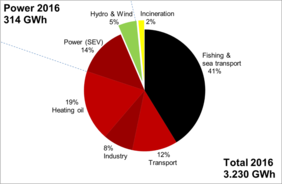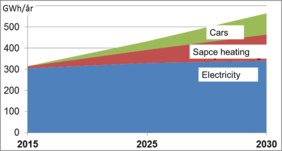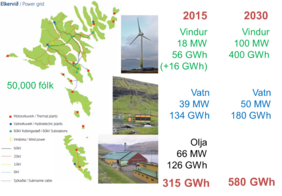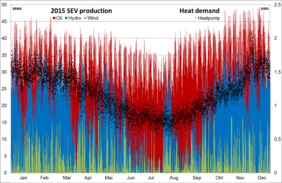The total energy use in the Faroe Islands is around 3.230 GWh. Most of the energy, around 93%, derives from imported fossil fuel. Electric energy account for approximately 10% or 314 GWh.
The Faroese Parliament Coalition Agreement signed September 14, 2015 has focus on development of renewables to minimize import of oil. Space heating, which today is mainly by oil burners, will be transformed to electric energy by heat pumps and on land transport will be transformed from fossil fuel cars to electric cars. The vision is that by 2030 all electric power will be produced by renewables. This should be the case even if the demand for electric power will be doubled from 300 GWh/year to 600 GWh/year because of electrification of space heating and transport.
Therefore the parliament has introduced initiatives to replace oil-burners by heat-pumps and to replace traditional cars by electric cars (no registration fee, VAT exempt, lower price for electricity to heat pumps etc.) In total, the electricity system in the Faroe Island consists of six isolated systems. Main (45,400 inhabitants), Suðuroy (4,600 inhabitants), Skúvoy (52 inhabitants), Stóra Dímun (7 inhabitants), Koltur (2 inhabitants), Fugloy (44 inhabitants) and Mykines (20 inhabitants).
During winter most of the electricity is produced by wind and hydro. However, during summer, there is less wind and rain and most of the electricity has to be produced by imported heavy fuel. Therefor there is a focus on solar energy that can replace the majority of the oil used during the summer period.





